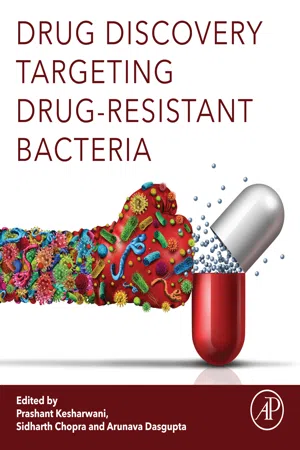
Drug Discovery Targeting Drug-Resistant Bacteria
- 432 pages
- English
- ePUB (mobile friendly)
- Available on iOS & Android
Drug Discovery Targeting Drug-Resistant Bacteria
About This Book
Drug Discovery Targeting Drug-Resistant Bacteria explores the status and possible future of developments in fighting drug-resistant bacteria. The book covers the majority of microbial diseases and the drugs targeting them. In addition, it discusses the potential targeting strategies and innovative approaches to address drug resistance. It brings together academic and industrial experts working on discovering and developing drugs targeting drug-resistant (DR) bacterial pathogens. New drugs active against drug-resistant pathogens are discussed, along with new strategies being used to discover molecules acting via new modes of action. In addition, alternative therapies such as peptides and phages are included.
Pharmaceutical scientists, microbiologists, medical professionals, pathologists, researchers in the field of drug discovery, infectious diseases and microbial drug discovery both in academia and in industrial settings will find this book helpful.
- Written by scientists with extensive industrial experience in drug discovery
- Provides a balanced view of the field, including its challenges and future directions
- Includes a special chapter on the identification and development of drugs against pathogens which exhibit the potential to be used as weapons of war
Frequently asked questions
Information
Foreword 1
Foreword 2
Acknowledgments
Antibiotics: past, present, and future
a Division of Microbiology, CSIR-Central Drug Research Institute, Lucknow, Uttar Pradesh, India
b Department of Pharmaceutics, School of Pharmaceutical Education and Research, Jamia Hamdard, New Delhi, India
c Department of Medicinal Chemistry, NIPER-HYD, Hyderabad, India
Abstract
1. Introduction
1.1. History and discovery of antimicrobials
Table of contents
- Cover
- Title page
- Contents
- Copyright
- Dedication
- Contributors
- Foreword 1
- Foreword 2
- Acknowledgments
- Chapter 1: Antibiotics: past, present, and future
- Chapter 2: Mechanisms of antibacterial drug resistance and approaches to overcome
- Chapter 3: Antibiotics targeting Gram-negative bacteria
- Chapter 4: Recent development of antibacterial agents to combat drug-resistant Gram-positive bacteria
- Chapter 5: Repurposing nonantibiotic drugs as antibacterials
- Chapter 6: Drugs against Mycobacterium tuberculosis
- Chapter 7: Combating biothreat pathogens: ongoing efforts for countermeasure development and unique challenges
- Chapter 8: New approaches to antibacterial drug discovery
- Chapter 9: New strategies and targets for antibacterial discovery
- Chapter 10: Importance of efflux pumps in subjugating antibiotic resistance
- Chapter 11: Phage therapy—bacteriophage and phage-derived products as anti-infective drugs
- Chapter 12: Drug discovery targeting drug-resistant nontuberculous mycobacteria
- Chapter 13: New strategies to combat drug resistance in bacteria
- Index